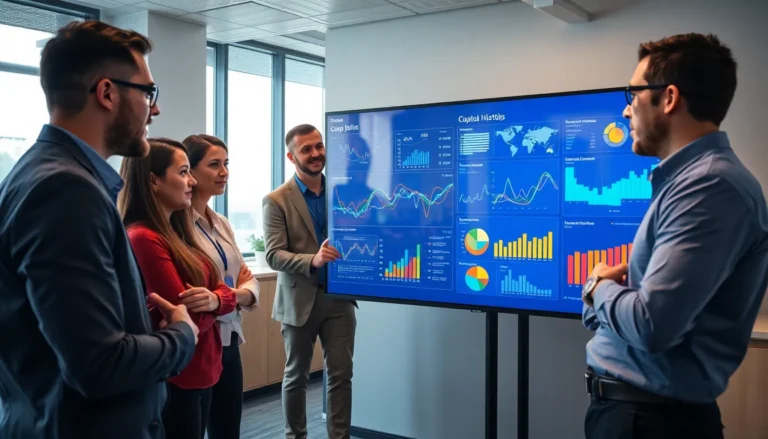In a world where predicting the future feels like trying to read tea leaves in a hurricane, smart forecasting swoops in like a superhero with a crystal ball. Businesses today face an avalanche of data, and without the right tools, they might as well be throwing darts blindfolded. Smart forecasting transforms chaos into clarity, helping companies anticipate trends and make data-driven decisions that don’t just keep them afloat but propel them forward.
Imagine having the power to foresee market shifts before they happen, allowing businesses to dodge pitfalls and seize opportunities like a pro. With smart forecasting, it’s not just about crunching numbers; it’s about turning insights into action. So, buckle up as we dive into the fascinating world of smart forecasting, where intuition meets innovation, and the future looks a little less foggy.
Table of Contents
ToggleOverview of Smart Forecasting
Smart forecasting leverages advanced analytics to transform vast amounts of data into actionable insights. Businesses utilize sophisticated algorithms that analyze historical data patterns, predicting future trends with accuracy. This approach helps organizations anticipate market shifts and consumer behaviors.
Integrating multiple data sources enhances the reliability of smart forecasting. By merging data from customer interactions, market research, and sales reports, companies gain a comprehensive view of potential challenges and opportunities. Such insights enable them to make informed decisions quickly.
Predictive analytics plays a crucial role in smart forecasting. The technology identifies patterns and trends, allowing businesses to simulate various scenarios. Accurate predictions help organizations minimize risks and maximize their strategic advantages.
Real-time data processing significantly improves the decision-making process. With instant access to updated information, companies can respond to market changes promptly. This agility contributes to maintaining a competitive edge.
Collaboration among cross-functional teams further strengthens the effectiveness of smart forecasting. Engaging departments such as marketing, sales, and finance fosters a unified approach to utilizing insights derived from data. This alignment ensures that everyone is on the same page, ultimately driving success.
Successful examples of smart forecasting demonstrate its impact on business performance. Companies in retail and finance have reported increased sales and improved inventory management through the adoption of smart forecasting techniques. Such evidence reinforces its value in a data-driven environment.
The implementation of smart forecasting requires a commitment to continuous improvement. Organizations must regularly assess and refine their forecasting methods. By doing so, they position themselves to adapt to the ever-evolving market landscape.
Benefits of Smart Forecasting

Smart forecasting offers several advantages that significantly enhance business operations. By employing advanced analytics tools, organizations can unlock the potential of their data for improved outcomes.
Enhanced Accuracy
Enhanced accuracy emerges as a primary benefit of smart forecasting. Algorithms analyze historical patterns, identifying trends that traditional methods may miss. Businesses experience better predictions, translating to a more precise understanding of future market shifts. Sophisticated models balance vast datasets, reducing bias in forecasts. This accuracy minimizes errors and helps companies align resources accordingly. Consistent precision streamlines inventory management and optimizes supply chain processes. For instance, retailers can prevent overstock situations, ensuring products align with customer demand.
Improved Decision-Making
Improved decision-making directly correlates with effective smart forecasting. Access to real-time insights empowers organizations to react swiftly to market fluctuations. Teams utilize predictive analytics to visualize various scenarios, enabling them to weigh options confidently. Organizations that embrace smart forecasting foster collaboration across departments, further enhancing decisions. Marketing teams gain clarity on customer preferences, while finance departments manage budgets effectively. Ultimately, informed choices lead to better strategic planning, resulting in increased competitiveness and profitability. Numerous studies illustrate these positive trends, underscoring the value of sound forecasting practices.
Technologies Behind Smart Forecasting
Smart forecasting relies on advanced technologies that enhance accuracy and efficiency in decision-making. Two key technologies include machine learning algorithms and data analytics tools, which work together to produce actionable insights.
Machine Learning Algorithms
Machine learning algorithms play a vital role in smart forecasting. These algorithms analyze large datasets, discovering patterns that traditional methods miss. Various techniques, such as regression analysis and neural networks, enable predictions about future trends based on historical data. By learning from new information continuously, these algorithms improve their accuracy over time. Organizations that employ machine learning benefit from increased flexibility and speed in adapting to market changes. Enhanced predictive capabilities not only reduce risk but also support strategic decision-making processes.
Data Analytics Tools
Data analytics tools are essential for interpreting and visualizing data in smart forecasting. These tools process vast amounts of information from diverse sources, transforming raw data into clear insights. Popular tools include Tableau, Power BI, and Google Analytics, which facilitate data exploration and reporting. Users can manipulate data to uncover trends and anomalies, making informed decisions based on evidence. Collaboration across departments benefits from the visualization features of these tools, allowing teams to share insights effectively. Ultimately, data analytics tools empower organizations to harness their data fully, leading to improved forecasting outcomes.
Applications of Smart Forecasting
Smart forecasting finds extensive applications across various industries, enhancing decision-making with precise predictions.
Retail Industry
In the retail sector, smart forecasting minimizes inventory costs and increases sales. Retailers utilize algorithms to analyze customer purchasing behaviors, seasonality, and market trends, leading to accurate demand predictions. These insights support effective inventory management, preventing stockouts and overstock situations. Brands like Walmart leverage this technology to optimize supply chain operations, resulting in reduced waste and improved customer satisfaction. Smart forecasting allows retailers to personalize marketing efforts, driving higher conversion rates by targeting specific customer segments with tailored promotions.
Financial Services
Financial services greatly benefit from smart forecasting by managing investment risks and maximizing returns. Institutions apply predictive analytics to assess market conditions and economic indicators, enabling informed investment strategies. Tools that analyze historical data provide insights into potential market fluctuations and trends. Banks utilize these forecasts to optimize loan offerings, ensuring appropriate interest rates align with projected customer demand. High-frequency trading firms rely on real-time data and algorithms to make instantaneous decisions, significantly enhancing trading outcomes. Smart forecasting not only improves risk management in finance but also drives strategic growth initiatives.
Challenges in Implementing Smart Forecasting
Organizations face several challenges when implementing smart forecasting strategies. Data quality issues often arise, as inaccurate or incomplete data can lead to flawed predictions. Ensuring that teams collect, clean, and maintain high-quality data sets becomes essential for effective forecasting.
Integration of diverse data sources presents another hurdle. Organizations struggle to consolidate information from various platforms and systems, making it difficult to achieve a holistic view of market conditions. Collaborative efforts are vital for unifying data across departments.
Training personnel on new technologies can be demanding. Teams may lack the expertise to utilize advanced analytics tools fully, which affects the effective use of smart forecasting methods. Providing adequate training and resources ensures team members can leverage these technologies.
Scalability concerns also hinder the process. As businesses grow, their forecasting needs change, and existing solutions may not meet increased demands. Adapting smart forecasting methods to accommodate growth requires ongoing assessment and flexibility.
Compliance with regulations poses additional challenges. Organizations must navigate legal requirements related to data handling and privacy, which can complicate the implementation of smart forecasting initiatives. Staying updated on relevant regulations is necessary to maintain compliance.
Additionally, buy-in from leadership and employees is crucial for success. Resistance to change can slow down the adoption of smart forecasting practices, making it important to communicate the benefits and value effectively. Engaging teams fosters a supportive environment for innovative forecasting solutions.
Smart forecasting stands as a pivotal strategy for businesses aiming to thrive in a rapidly changing market. Its ability to transform complex data into actionable insights empowers organizations to make informed decisions and seize opportunities. By leveraging advanced analytics and predictive capabilities, companies can navigate uncertainties with confidence.
The continuous evolution of technology ensures that smart forecasting will only improve over time. As organizations commit to refining their forecasting methods and embracing collaboration across departments, they position themselves to achieve greater accuracy and agility. In a world where data is abundant, smart forecasting is not just an advantage; it’s a necessity for sustainable growth and success.









